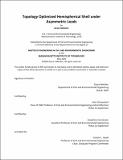| dc.contributor.advisor | John Ochsendorf and Josephine Carstensen. | en_US |
| dc.contributor.author | Melcher, Grace(Grace E.) | en_US |
| dc.contributor.other | Massachusetts Institute of Technology. Department of Civil and Environmental Engineering. | en_US |
| dc.date.accessioned | 2020-09-15T21:51:47Z | |
| dc.date.available | 2020-09-15T21:51:47Z | |
| dc.date.copyright | 2020 | en_US |
| dc.date.issued | 2020 | en_US |
| dc.identifier.uri | https://hdl.handle.net/1721.1/127315 | |
| dc.description | Thesis: M. Eng., Massachusetts Institute of Technology, Department of Civil and Environmental Engineering, May, 2020 | en_US |
| dc.description | Cataloged from the official PDF of thesis. | en_US |
| dc.description | Includes bibliographical references (pages 48-50). | en_US |
| dc.description.abstract | Domes are an efficient way to span long distances and resist gravity loads. The two kinds of classical domes prevalent in architecture are continuous shells and grid shells. Continuous shells are monolithic concrete or masonry; grid shells reorient material in lattice members to create depth throughout the shell thickness. This thesis considers the design of a topology optimized hemisphere, a hemispherical continuous shell, and a hemispherical grid shell, and compares the structural performance of these three shells under asymmetric loads. First, a novel topology optimized dome is defined and generated with the objective to minimize strain energy. Then a numerical study is conducted on the three shells, continuous, grid, and optimized hemisphere, to investigate the different structural behavior of each material design scheme. This includes a linear elastic finite element analysis of each hemisphere's response under its own buckling load. Finally, plastic analyses are presented including the effects of large deformations and material yielding to determine the optimized hemisphere's response in comparison to the classical hemispheres. The proposed method uses topology optimization over the new domain of a thin shell lofted into space, as opposed to the more common planar and three-dimensional spaces for structural optimization. This thesis demonstrates good correlation of load capacity between Timoshenko's theoretical predictions and numerical analysis using Abaqus. The proposed topology optimized hemisphere has a seven-fold increase in load capacity under asymmetrical loading, when compared to a grid shell of the same volume. | en_US |
| dc.description.statementofresponsibility | by Grace Melcher. | en_US |
| dc.format.extent | 50 pages | en_US |
| dc.language.iso | eng | en_US |
| dc.publisher | Massachusetts Institute of Technology | en_US |
| dc.rights | MIT theses may be protected by copyright. Please reuse MIT thesis content according to the MIT Libraries Permissions Policy, which is available through the URL provided. | en_US |
| dc.rights.uri | http://dspace.mit.edu/handle/1721.1/7582 | en_US |
| dc.subject | Civil and Environmental Engineering. | en_US |
| dc.title | Topology optimized hemispherical shell under asymmetric loads | en_US |
| dc.type | Thesis | en_US |
| dc.description.degree | M. Eng. | en_US |
| dc.contributor.department | Massachusetts Institute of Technology. Department of Civil and Environmental Engineering | en_US |
| dc.identifier.oclc | 1191905952 | en_US |
| dc.description.collection | M.Eng. Massachusetts Institute of Technology, Department of Civil and Environmental Engineering | en_US |
| dspace.imported | 2020-09-15T21:51:46Z | en_US |
| mit.thesis.degree | Master | en_US |
| mit.thesis.department | CivEng | en_US |
